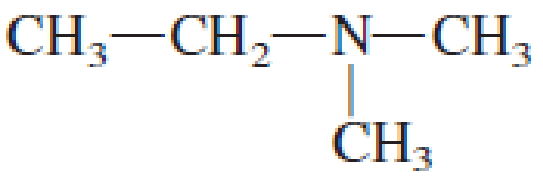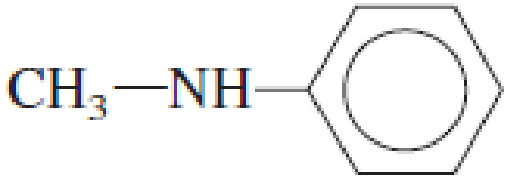
EBK GENERAL, ORGANIC, AND BIOLOGICAL CH
7th Edition
ISBN: 9780100853188
Author: STOKER
Publisher: YUZU
expand_more
expand_more
format_list_bulleted
Concept explainers
Textbook Question
Chapter 17, Problem 17.8EP
Indicate whether or not each of the following compounds contains an




Expert Solution & Answer
Want to see the full answer?
Check out a sample textbook solution
Students have asked these similar questions
"Water gas" is an industrial fuel composed of a mixture of carbon monoxide and hydrogen gases. When this
fuel is burned, carbon dioxide and water result. From the information given below, write a balanced equation
and determine the enthalpy of this reaction:
CO(g) + O2(g) → CO₂(g) + 282.8 kJ
H2(g) + O2(g) → H₂O(g) + 241.8 kJ
MacBook Air
Page of 3
4. Calculate AG for the following reaction at 25°C. Will the reaction occur (be spontaneous)? How do you
know?
NH3(g) + HCl(g) → NH4Cl(s)
AH=-176.0 kJ
AS-284.8 J-K-1
true or false
The equilibrium constant for this reaction is 0.20.
N2O4(g) ⇔ 2NO2(g)
Based on the above, the equilibrium constant for the following reaction is 5.
4NO2(g) ⇔ 2N2O4(g)
Chapter 17 Solutions
EBK GENERAL, ORGANIC, AND BIOLOGICAL CH
Ch. 17.1 - Prob. 1QQCh. 17.1 - Prob. 2QQCh. 17.2 - Prob. 1QQCh. 17.2 - Prob. 2QQCh. 17.2 - Prob. 3QQCh. 17.2 - Prob. 4QQCh. 17.3 - Prob. 1QQCh. 17.3 - Prob. 2QQCh. 17.3 - Prob. 3QQCh. 17.3 - Prob. 4QQ
Ch. 17.4 - Prob. 1QQCh. 17.4 - Prob. 2QQCh. 17.5 - Prob. 1QQCh. 17.5 - Prob. 2QQCh. 17.5 - Prob. 3QQCh. 17.6 - Prob. 1QQCh. 17.6 - Prob. 2QQCh. 17.6 - Prob. 3QQCh. 17.7 - Prob. 1QQCh. 17.7 - Prob. 2QQCh. 17.7 - Prob. 3QQCh. 17.8 - Prob. 1QQCh. 17.8 - Prob. 2QQCh. 17.8 - Prob. 3QQCh. 17.8 - Prob. 4QQCh. 17.9 - Prob. 1QQCh. 17.9 - Prob. 2QQCh. 17.10 - Prob. 1QQCh. 17.10 - Prob. 2QQCh. 17.10 - Prob. 3QQCh. 17.10 - Prob. 4QQCh. 17.11 - Prob. 1QQCh. 17.11 - Prob. 2QQCh. 17.11 - Prob. 3QQCh. 17.12 - Prob. 1QQCh. 17.12 - Prob. 2QQCh. 17.12 - Prob. 3QQCh. 17.12 - Prob. 4QQCh. 17.13 - Prob. 1QQCh. 17.13 - Prob. 2QQCh. 17.13 - Prob. 3QQCh. 17.13 - Prob. 4QQCh. 17.14 - Prob. 1QQCh. 17.14 - Prob. 2QQCh. 17.14 - Prob. 3QQCh. 17.15 - Prob. 1QQCh. 17.15 - Prob. 2QQCh. 17.16 - Prob. 1QQCh. 17.16 - Prob. 2QQCh. 17.16 - Prob. 3QQCh. 17.17 - Prob. 1QQCh. 17.17 - Prob. 2QQCh. 17.17 - Prob. 3QQCh. 17.18 - Prob. 1QQCh. 17.18 - Prob. 2QQCh. 17.18 - Prob. 3QQCh. 17.19 - Prob. 1QQCh. 17.19 - Prob. 2QQCh. 17.19 - Prob. 3QQCh. 17.19 - Prob. 4QQCh. 17 - Prob. 17.1EPCh. 17 - Prob. 17.2EPCh. 17 - Prob. 17.3EPCh. 17 - Prob. 17.4EPCh. 17 - Prob. 17.5EPCh. 17 - Prob. 17.6EPCh. 17 - Indicate whether or not each of the following...Ch. 17 - Indicate whether or not each of the following...Ch. 17 - Prob. 17.9EPCh. 17 - Prob. 17.10EPCh. 17 - Prob. 17.11EPCh. 17 - Prob. 17.12EPCh. 17 - Prob. 17.13EPCh. 17 - Prob. 17.14EPCh. 17 - Prob. 17.15EPCh. 17 - Assign a common name to each of the following...Ch. 17 - Prob. 17.17EPCh. 17 - Prob. 17.18EPCh. 17 - Prob. 17.19EPCh. 17 - Prob. 17.20EPCh. 17 - Prob. 17.21EPCh. 17 - Prob. 17.22EPCh. 17 - Prob. 17.23EPCh. 17 - Prob. 17.24EPCh. 17 - Prob. 17.25EPCh. 17 - Prob. 17.26EPCh. 17 - Prob. 17.27EPCh. 17 - Prob. 17.28EPCh. 17 - Prob. 17.29EPCh. 17 - Prob. 17.30EPCh. 17 - Prob. 17.31EPCh. 17 - Prob. 17.32EPCh. 17 - Prob. 17.33EPCh. 17 - Prob. 17.34EPCh. 17 - Determine the maximum number of hydrogen bonds...Ch. 17 - Prob. 17.36EPCh. 17 - Prob. 17.37EPCh. 17 - Prob. 17.38EPCh. 17 - Prob. 17.39EPCh. 17 - Prob. 17.40EPCh. 17 - Prob. 17.41EPCh. 17 - Prob. 17.42EPCh. 17 - Prob. 17.43EPCh. 17 - Prob. 17.44EPCh. 17 - Prob. 17.45EPCh. 17 - Prob. 17.46EPCh. 17 - Prob. 17.47EPCh. 17 - Prob. 17.48EPCh. 17 - Prob. 17.49EPCh. 17 - Prob. 17.50EPCh. 17 - Prob. 17.51EPCh. 17 - Prob. 17.52EPCh. 17 - Prob. 17.53EPCh. 17 - Prob. 17.54EPCh. 17 - Prob. 17.55EPCh. 17 - Prob. 17.56EPCh. 17 - Prob. 17.57EPCh. 17 - Prob. 17.58EPCh. 17 - Prob. 17.59EPCh. 17 - Prob. 17.60EPCh. 17 - Prob. 17.61EPCh. 17 - Prob. 17.62EPCh. 17 - Prob. 17.63EPCh. 17 - Prob. 17.64EPCh. 17 - Prob. 17.65EPCh. 17 - Prob. 17.66EPCh. 17 - Prob. 17.67EPCh. 17 - Prob. 17.68EPCh. 17 - Prob. 17.69EPCh. 17 - Prob. 17.70EPCh. 17 - Prob. 17.71EPCh. 17 - Prob. 17.72EPCh. 17 - Prob. 17.73EPCh. 17 - Prob. 17.74EPCh. 17 - Prob. 17.75EPCh. 17 - Prob. 17.76EPCh. 17 - Prob. 17.77EPCh. 17 - Prob. 17.78EPCh. 17 - Prob. 17.79EPCh. 17 - Prob. 17.80EPCh. 17 - Prob. 17.81EPCh. 17 - Prob. 17.82EPCh. 17 - Prob. 17.83EPCh. 17 - Prob. 17.84EPCh. 17 - Prob. 17.85EPCh. 17 - Prob. 17.86EPCh. 17 - Prob. 17.87EPCh. 17 - Prob. 17.88EPCh. 17 - Prob. 17.89EPCh. 17 - Prob. 17.90EPCh. 17 - Prob. 17.91EPCh. 17 - Prob. 17.92EPCh. 17 - Prob. 17.93EPCh. 17 - Prob. 17.94EPCh. 17 - Prob. 17.95EPCh. 17 - Prob. 17.96EPCh. 17 - Prob. 17.97EPCh. 17 - Prob. 17.98EPCh. 17 - Indicate whether or not each of the following...Ch. 17 - Indicate whether or not each of the following...Ch. 17 - Classify each of the following amides as...Ch. 17 - Classify each of the following amides as...Ch. 17 - Classify each of the amides in Problem 17-101 as a...Ch. 17 - Prob. 17.104EPCh. 17 - Prob. 17.105EPCh. 17 - Prob. 17.106EPCh. 17 - Prob. 17.107EPCh. 17 - Prob. 17.108EPCh. 17 - Prob. 17.109EPCh. 17 - Prob. 17.110EPCh. 17 - Assign an IUPAC name to each of the following...Ch. 17 - Assign an IUPAC name to each of the following...Ch. 17 - Prob. 17.113EPCh. 17 - Prob. 17.114EPCh. 17 - Prob. 17.115EPCh. 17 - Prob. 17.116EPCh. 17 - Prob. 17.117EPCh. 17 - Prob. 17.118EPCh. 17 - Prob. 17.119EPCh. 17 - What is the relationship between the acronym DEET...Ch. 17 - Prob. 17.121EPCh. 17 - Prob. 17.122EPCh. 17 - Prob. 17.123EPCh. 17 - Prob. 17.124EPCh. 17 - Prob. 17.125EPCh. 17 - Prob. 17.126EPCh. 17 - Prob. 17.127EPCh. 17 - Prob. 17.128EPCh. 17 - Prob. 17.129EPCh. 17 - Prob. 17.130EPCh. 17 - Prob. 17.131EPCh. 17 - Prob. 17.132EPCh. 17 - Prob. 17.133EPCh. 17 - Prob. 17.134EPCh. 17 - Prob. 17.135EPCh. 17 - Prob. 17.136EPCh. 17 - Prob. 17.137EPCh. 17 - Prob. 17.138EPCh. 17 - Prob. 17.139EPCh. 17 - Prob. 17.140EPCh. 17 - Prob. 17.141EPCh. 17 - Prob. 17.142EPCh. 17 - Prob. 17.143EPCh. 17 - Prob. 17.144EPCh. 17 - Prob. 17.145EPCh. 17 - Prob. 17.146EPCh. 17 - Prob. 17.147EPCh. 17 - Prob. 17.148EPCh. 17 - Prob. 17.149EPCh. 17 - Prob. 17.150EPCh. 17 - Prob. 17.151EPCh. 17 - Prob. 17.152EPCh. 17 - Prob. 17.153EPCh. 17 - Prob. 17.154EP
Knowledge Booster
Learn more about
Need a deep-dive on the concept behind this application? Look no further. Learn more about this topic, biology and related others by exploring similar questions and additional content below.Similar questions
- true or false The equilibrium constant for this reaction is 0.20. N2O4(g) ⇔ 2NO2(g) Based on the above, the equilibrium constant for the following reaction is 0.4. 2N2O4(g) ⇔ 4NO2(g)arrow_forwardtrue or false Using the following equilibrium, if heat is added the equilibrium will shift toward the reactants. N2(g) + 3H2(g) ⇔ 2NH3(g) + heatarrow_forwardTrue or False Using the following equilibrium, if heat is added the equilibrium will shift toward the products. N2O4(g) + heat ⇔ 2NO2(g)arrow_forward
- true or false Using the following equilibrium, if solid carbon is added the equilibrium will shift toward the products. C(s) + CO2(g) ⇔ 2CO(g)arrow_forwardProvide the complete mechanism for the reaction below. You must include appropriate arrows,intermediates, and formal charges. Please also provide a reason to explain why the 1,4-adduct is preferred over the 1,3-adduct.arrow_forwardWhich of the following pairs are resonance structures of one another? I. III. || III IV + II. :0: n P !༠ IV. EN: Narrow_forward
- Predict the major organic product(s) and byproducts (either organic or inorganic) for thefollowing reactions.arrow_forwardA 8.25 g sample of aluminum at 55°C released 2500 J of heat. The specific heat of aluminum is 0.900 J/g°C. The density of aluminum is 2.70 g/mL. Calculate the final temperature of the aluminum sample in °C.arrow_forwardPredict the major organic product(s) and byproducts (either organic or inorganic) for thefollowing reactions.arrow_forward
- Predict the major organic product(s) and byproducts (either organic or inorganic) for thefollowing reaction.arrow_forwardplease helparrow_forwardExperiment 1 Data Table 1: Conservation of Mass - Initial Mass Data Table 1 Data Table 2 Data Table 3 Data Table 4 Panel 1 Photo 1 Data Table 5 Reaction Mass of test tube and 5.0% HC₂H₂O2 (g) # (A) (B) Mass of NaHCO, (g) Mass of balloon and NaHCO, (g) (C) 0.10 1 0829 14.38g 0.20 2 0.929 14.29g 0.35 1.00g 3 14.25g 0.50 1.14g 14.29 Experiment 1 Data Table 2: Moles of HC2H3O2 Reaction Volume of Mass of Moles of HC₂H₂O₂ 5.0% Vinegar (g) (ML) 5.0 0.25 0042 mol 2 5.0 0.25 0042 mol 3 5.0 0.25 0042 mol 5.0 0.25 0042 mol Experiment 1 Data Table 3: Moles of NaHCO3 Reaction Mass of NaHCO (g) 10g 20g 35g 50g Experiment 1 Data Table 4: Theoretical Yield of CO₂ Reaction # 1 2 3 Experiment 1 Total mass before reaction (g) (D=A+C) 15.29 15.21g 15.25g 15.349 Exercise 1 Data Table 1 Data Table 2 Data Table 3 Data Table 4 Panel 1 Photo 1 Data Table 5 Exercise 1- Data Table 1 Data Table 2 DataTable 3 Data Table 4 Panel 1 Photo 1 Data Table 5 Exercise 1- Moles of NaHCO 0012 mol 0025 mol 0044 mol 0062 mol…arrow_forward
arrow_back_ios
SEE MORE QUESTIONS
arrow_forward_ios
Recommended textbooks for you
 General, Organic, and Biological ChemistryChemistryISBN:9781285853918Author:H. Stephen StokerPublisher:Cengage Learning
General, Organic, and Biological ChemistryChemistryISBN:9781285853918Author:H. Stephen StokerPublisher:Cengage Learning Organic And Biological ChemistryChemistryISBN:9781305081079Author:STOKER, H. Stephen (howard Stephen)Publisher:Cengage Learning,
Organic And Biological ChemistryChemistryISBN:9781305081079Author:STOKER, H. Stephen (howard Stephen)Publisher:Cengage Learning, Chemistry for Today: General, Organic, and Bioche...ChemistryISBN:9781305960060Author:Spencer L. Seager, Michael R. Slabaugh, Maren S. HansenPublisher:Cengage Learning
Chemistry for Today: General, Organic, and Bioche...ChemistryISBN:9781305960060Author:Spencer L. Seager, Michael R. Slabaugh, Maren S. HansenPublisher:Cengage Learning- Chemistry: Matter and ChangeChemistryISBN:9780078746376Author:Dinah Zike, Laurel Dingrando, Nicholas Hainen, Cheryl WistromPublisher:Glencoe/McGraw-Hill School Pub Co

General, Organic, and Biological Chemistry
Chemistry
ISBN:9781285853918
Author:H. Stephen Stoker
Publisher:Cengage Learning

Organic And Biological Chemistry
Chemistry
ISBN:9781305081079
Author:STOKER, H. Stephen (howard Stephen)
Publisher:Cengage Learning,

Chemistry for Today: General, Organic, and Bioche...
Chemistry
ISBN:9781305960060
Author:Spencer L. Seager, Michael R. Slabaugh, Maren S. Hansen
Publisher:Cengage Learning

Chemistry: Matter and Change
Chemistry
ISBN:9780078746376
Author:Dinah Zike, Laurel Dingrando, Nicholas Hainen, Cheryl Wistrom
Publisher:Glencoe/McGraw-Hill School Pub Co
Nomenclature: Crash Course Chemistry #44; Author: CrashCourse;https://www.youtube.com/watch?v=U7wavimfNFE;License: Standard YouTube License, CC-BY